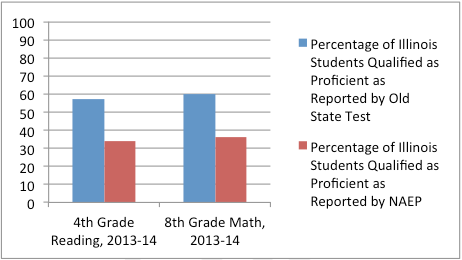Closing the “Honesty Gap” in Illinois
 Click here to see updated data for this state.
Click here to see updated data for this state.
As with most states, discrepancies have emerged between student proficiency rates as reported by Illinois’ state tests and the National Assessment of Educational Progress (NAEP), most commonly called “the Nation’s Report Card.” For the 2013-14 school year, Illinois showed a 23-point discrepancy between state reported proficiency scores and NAEP in fourth-grade reading, and a 24-point discrepancy in eighth-grade math.
In Illinois, the standard for proficiency and minimum score is set by the State Board of Education. 1
Illinois K-12 Education at a Glance:
- K-12 Student Population: 2,072,091 2
- HS Graduation Rate: 83.2% (2013) 3
- College Enrollment: 58.7% (2010) 4
- College Remediation Rate: 48.7% Two-Year Programs 5
Consequences of the Honesty Gap in Illinois: Of the Illinois students that require remediation at four-year colleges, only 27.3 percent go on to earn a degree within six years. Similarly, only 14 percent of college students requiring remediation in two-year schools complete a degree within three years.6 Nationally, developmental education costs students and taxpayers about $7 billion each year.7
How Illinois Is Working to Close the Honesty Gap: In 2010 Illinois adopted college- and career-ready standards in English Language Arts (ELA) and math (the Illinois Common Core Standards). In the 2014-15 school year, Illinois chose to give the new PARCC test in order to have a more accurate understanding of students’ real-world, critical thinking, math and writing skills. With the adoption of higher standards and aligned assessments, Illinois is well along on the road to becoming a top truth teller. Parents and educators will get new information by this fall that will help them know the truth about how their child is doing – and how well their state is preparing kids for success after high school.
States Leading the Way: More than half of all states demonstrated a 30-percentage point or more differential between their calculated proficiency rates and NAEP. Some states, such as Kentucky, Alabama, and Tennessee took early steps to correct the Honesty Gap with promising results. Kentucky previously had some of the nation’s largest gaps, but after adopting a new, high-quality assessment, became one of the “Top Truth Tellers” in eighth-grade math, narrowing a 32-percentage point discrepancy to 15 between 2011 and 2014. Additionally, between 2012 and 2014, the number of eleventh-grade students meeting college-readiness benchmarks on the ACT college entrance test increased by 15 percentage points.
Alabama also had huge discrepancies between their state tests and NAEP. In 2014, less than half of Alabama’s students were on track to be ready for college in both subjects at almost every grade level. That year students began taking a new test, which dramatically narrowed the gap by 50 points in fourth-grade reading alone. After Tennessee revised their state test in 2010, not only did their discrepancies between NAEP and the state assessment narrow, but by 2013, they were the fastest improving state in the nation. With the adoption of new, high-quality assessments, each of these states has narrowed the discrepancies between their assessments and NAEP scores and all are among the top truth-tellers in the country.
For more information read more: What is the Honesty Gap?
Back to Map
